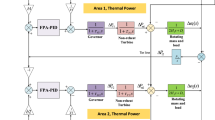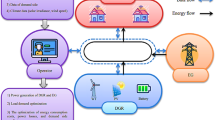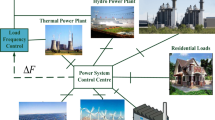Abstract
The ancillary services are becoming more important due to the increasing integration of non-dispatchable and intermittent renewable energy sources. Such behavior under deregulation necessitates the procurement of these services suitably. This paper presents the multi-objective procurement of voltage control ancillary service in a dynamic pool deregulated system that is contingent to wind and solar power generation uncertainties. The shunt capacitors bid to supply this service and their switchings, although restricted due to life expectancy, depend on locational marginal prices. An improved multi-objective artificial electric field algorithm, which adopts the concept of Pareto-based non-dominated sorting, is presented to co-optimize total cost and voltage deviation. The particle’s positions are updated through randomly picked Pareto solution to enhance exploitation capability. The sign and reorder mutation operations are employed to maintain diversity in the population, improve exploration, and evade local optima trap. The performance is investigated for different levels of wind and solar penetration on IEEE 30-bus and IEEE 118-bus test systems. The convergence of presented algorithm is analyzed and compared with other algorithms through statistical metrics and associated boxplots.












Similar content being viewed by others
Abbreviations
- AEFA:
-
Artificial electric field algorithm
- AS:
-
Ancillary services
- I-MOAEFA:
-
Improved multi-objective AEFA
- LMP:
-
Locational marginal price
- MOAEFA:
-
Multi-objective AEFA
- MOPSO:
-
Multi-objective PSO
- PDF:
-
Probability density function
- PSO:
-
Particle swarm optimization
- PV:
-
Photovoltaic
- RES:
-
Renewable energy sources
- SO:
-
System operator
- VAr:
-
Reactive power
- VCAS:
-
Voltage control ancillary service
- \(C_\textrm{R}\), \(C_\textrm{P}\) :
-
Reserve and penalty cost functions
- \(C_\textrm{gps}\), \(d_\textrm{s}\) :
-
Active power generation cost and cost coefficient of \(s\textrm{th}\) solar unit
- \(C_\textrm{gpu}\), \(C_\textrm{gqu}\) :
-
Active and reactive power generation cost of \(u\textrm{th}\) thermal unit
- \(C_\textrm{gpw}\), \(C_{gqw}\) :
-
Active and reactive power generation cost of \(w\textrm{th}\) wind unit
- \(C_{opu}\), \(C_\textrm{opw}\) :
-
Opportunity cost of \(u\textrm{th}\) thermal unit and \(w\textrm{th}\) wind unit
- \(C_\textrm{vsh}\), \(C_\textrm{dsh}\) :
-
Reactive power supply cost and depreciation cost of \(sh\textrm{th}\) shunt capacitor
- E :
-
Expectation of available power power
- LMP, IC :
-
Locational marginal price and investment cost of capacitor
- \(N^{-}\), \(N^{+}\) :
-
Number of discrete bins on left and right side of scheduled power
- \(N_\textrm{b}\), \(N_{s\mathrm h}\), \(N_\textrm{pq}\) :
-
Number of buses, shunt capacitors, and load buses
- \(N_\textrm{u}\), \(N_\textrm{w}\), \(N_\textrm{s}\) :
-
Number of thermal, wind, and solar units
- \(P_\textrm{R}\), \(P_\textrm{gw}\) :
-
Rated and scheduled active power from \(w\textrm{th}\) wind unit
- \(P_\textrm{S}\), \(P_\textrm{gs}\) :
-
Rated and scheduled active power from \(s\textrm{th}\) solar unit
- \(P_\textrm{gu}\), \(Q_\textrm{gu}\) :
-
Active and reactive power generation from \(u\textrm{th}\) thermal unit
- \(P_\textrm{gw}^{a\mathrm l}\), \(P_\textrm{gs}^\textrm{al}\) :
-
Available active power from \(w\textrm{th}\) wind and \(s\textrm{th}\) solar unit
- \(P_\mathrm{wn+}\), \(P_\mathrm{sn+}\) :
-
Available wind and solar power output more than scheduled power
- \(P_\mathrm{wn-}\), \(P_\mathrm{sn-}\) :
-
Available wind and solar power output less than scheduled power
- \(Q_\textrm{R}\), \(Q_\textrm{gw}\) :
-
Rated and scheduled VAr from \(w\textrm{thth}\) wind unit
- \(Q_\textrm{c}\), \(Q_\textrm{sh}\) :
-
VAr capacity and output of shunt capacitor
- \(R_\textrm{c}\), \(I_\textrm{std}\) :
-
Certain irradiance point and standard solar irradiance
- \(S_\textrm{jk}\) :
-
Line flow between buses j and k
- \(V_\textrm{p}\) :
-
Voltage magnitudes of \(p\textrm{th}\) bus
- \(\varDelta Q_\textrm{sh}\), \(R_\textrm{p}\) :
-
Change in shunt capacitor’s output and efficiency rate of reactive power
- \(\bar{S_\textrm{u}}\), \(\bar{S_\textrm{w}}\) :
-
Maximum apparent power of \(u\textrm{th}\) thermal unit and \(w\textrm{th}\) wind unit
- \(\gamma \), \(\beta \) :
-
Scale and shape parameter for Weibull PDF
- \(\mu \), \(\sigma \) :
-
Mean and standard deviation of Log-normal PDF
- \(a'_\textrm{u}\), \(b'_\textrm{u}\), \(c'_\textrm{u}\) :
-
Reactive power cost coefficients of \(u\textrm{th}\) thermal unit
- \(a_\textrm{u}\), \(b_\textrm{u}\), \(c_\textrm{u}\) :
-
Active power cost coefficients of \(u\textrm{th}\) thermal unit
- \(d_\textrm{w}\), \(d'_\textrm{w}\) :
-
Active and reactive power cost coefficient of \(w\textrm{th}\) wind unit
- \(f_{sn-}\), \(f_{sn+}\) :
-
Relative frequency of \(P_{sn-}\) and \(P_{sn+}\) occurrence
- \(f_\textrm{s}\), \(f_\textrm{w}\) :
-
Probability of available solar and wind power, respectively
- \(f_\textrm{v}(v)\), \(f_\textrm{I}(I)\) :
-
Weibull and Log-normal PDFs
- \(f_\mathrm{wn-}\), \(f_\mathrm{wn+}\) :
-
Relative frequency of \(P_{wn-}\) and \(P_{wn+}\) occurrence
- \(k_\textrm{R}\), \(k_\textrm{P}\) :
-
Reserve and penalty cost coefficient
- n :
-
Number of switching for capacitors
- t, \(N_\textrm{T}\) :
-
Time interval in hours and total time period
- v, I :
-
Speed of the wind and solar irradiation
- \(v_\textrm{in}\), \(v_{o}\), \(v_\textrm{r}\) :
-
Cut-in, cut-out, and rated wind speed
- \(E_{k}\), \(Q_{k}\) :
-
Electric field and charge of \(k\textrm{th}\) agent
- \(F_{k}\), \(M_{k}\) :
-
Total force and inertial mass on \(k\textrm{th}\) agent
- K, \(K_{0}\) :
-
Coulomb constant and its initial value
- \(N_{a}\), \(N_\textrm{ob}\), D :
-
Number of agents, objectives, and non-dominated solutions
- \(O_{j}\) :
-
Objective function
- \(P_\textrm{best}\) :
-
Set of agents with best fitness value and biggest mass
- \(P_{m}\), \(P_{s}\) :
-
Reorder and sign mutation probability
- \(V_{k}^{\prime }\), \(V_{k}^{\prime \prime }\) :
-
Updated velocity using sign and reorder mutation operator
- \(X_{Gb}\), \({\textbf {X}}_\textrm{Gbest}\) :
-
Global best value and set of non-dominated solutions
- \(X_{k}\), \(V_{k}\), \(a_{k}\) :
-
Position, velocity, and acceleration of \(k\textrm{th}\) agent
- \(\bar{d}\), \(\mu _{j}\) :
-
Average of all distances \(d_{a}\) and membership function
- \(d_{a}\), \(d_{n}\), \(d_{x}\) :
-
Euclidean distance between adjacent, boundary, and extreme solutions
- \(fit_{k}\), \(p_{k}\) :
-
Fitness value and position of best fitness value attained by \(k\textrm{th}\) agent
- i, \(i\textrm{max}\) :
-
Current iteration number and total number of iterations
References
Shahidehpour M, Yamin H, Li Z (2002) Market operations in electric power systems. Wiley, New York
Anaya KL, Pollitt MG (2020) Reactive power procurement: a review of current trends. Appl Energy 270:114939. https://doi.org/10.1016/j.apenergy.2020.114939
Jay D, Swarup S (2021) A comprehensive survey on reactive power ancillary service markets. Renew Sustain Energy Rev 144:110967. https://doi.org/10.1016/j.rser.2021.110967
Ciupăgeanu DA, Lăzăroiu G, Barelli L (2019) Wind energy integration: variability analysis and power system impact assessment. Energy 185:1183–1196. https://doi.org/10.1016/j.energy.2019.07.136
Zhang S, Tseng K, Choi S (2010) Statistical voltage quality assessment method for grids with wind power generation. IET Renew Power Gener 4:43–54. https://doi.org/10.1049/iet-rpg.2008.0067
Ullah NR, Bhattacharya K, Thiringer T (2009) Wind farms as reactive power ancillary service providers; technical and economic issues. IEEE Trans Energy Convers 24(3):661–672. https://doi.org/10.1109/TEC.2008.2008957
Samal RK, Tripathy M (2019) Cost savings and emission reduction capability of wind-integrated power systems. Int J Electr Power Energy Syst 104:549–561. https://doi.org/10.1016/j.ijepes.2018.07.039
Basu M (2019) Multi-region dynamic economic dispatch of solar-wind-hydro-thermal power system incorporating pumped hydro energy storage. Eng Appl Artif Intell 86:182–196. https://doi.org/10.1016/j.engappai.2019.09.001
Konjevod J, Krajcar S, Ilak P (2017) The real-time coordination of a wind-hydro power generation. J Energy 66:4–17. https://doi.org/10.37798/2017661-493
Riddervold HO, Aasgard EK, Haukaas L, Korpas M (2021) Internal hydro- and wind portfolio optimisation in real-time market operations. Renew Energy 173:675–687. https://doi.org/10.1016/j.renene.2021.04.001
Reddy SS, Momoh JA (2015) Realistic and transparent optimum scheduling strategy for hybrid power system. IEEE Trans Smart Grid 6(6):3114–3125. https://doi.org/10.1109/TSG.2015.2406879
Hansen AD, Altin M, Iov F (2016) Provision of enhanced ancillary services from wind power plants - examples and challenges. Renew Energy 97:8–18. https://doi.org/10.1016/j.renene.2016.05.063
Biswas PP, Suganthan P, Amaratunga GA (2017) Optimal power flow solutions incorporating stochastic wind and solar power. Energy Convers Manage 148:1194–1207. https://doi.org/10.1016/j.enconman.2017.06.071
Reddy S, Bijwe PR, Abhyankar AR (2015) Real-time economic dispatch considering renewable power generation variability and uncertainty over scheduling period. IEEE Syst J 9(4):1440–1451. https://doi.org/10.1109/JSYST.2014.2325967
Liang RH, Liao JH (2007) A fuzzy-optimization approach for generation scheduling with wind and solar energy systems. IEEE Trans Power Syst 22(4):1665–1674. https://doi.org/10.1109/TPWRS.2007.907527
Jay D, Swarup KS (2021) Game theoretical approach to novel reactive power ancillary service market mechanism. IEEE Trans Power Syst 36(2):1298–1308. https://doi.org/10.1109/TPWRS.2020.3019786
Ketabi A, Alibabaee A, Feuillet R (2010) Application of the ant colony search algorithm to reactive power pricing in an open electricity market. Int J Electr Power Energy Syst 32(6):622–628. https://doi.org/10.1016/j.ijepes.2009.11.019
Malakar T, Rajan A, Jeevan K, Dhar P (2016) A day ahead price sensitive reactive power dispatch with minimum control. Int J Electr Power Energy Syst 81:427–443. https://doi.org/10.1016/j.ijepes.2016.02.035
Konidena R (2020) A proposal for compensating reactive support and voltage control in miso p 106785
Ahmadimanesh A, Kalantar M (2017) Two new frameworks for reactive power market considering reactive losses. Int J Electr Power Energy Syst 27(10):e2387. https://doi.org/10.1002/etep.2387
Liang RH, Wang JC, Chen YT, Tseng WT (2015) An enhanced firefly algorithm to multi-objective optimal active/reactive power dispatch with uncertainties consideration. Int J Electr Power Energy Syst 64:1088–1097. https://doi.org/10.1016/j.ijepes.2014.09.008
Biswas PP, Suganthan P, Mallipeddi R, Amaratunga GA (2019) Optimal reactive power dispatch with uncertainties in load demand and renewable energy sources adopting scenario-based approach. Appl Soft Comput 75:616–632. https://doi.org/10.1016/j.asoc.2018.11.042
Khazali A, Kalantar M, Khazali A (2011) Fuzzy multi-objective reactive power clearing considering reactive compensation sources. Energy 36:3319–3327. https://doi.org/10.1016/j.energy.2011.03.027
Reddy S, Abhyankar AR, Bijwe PR (2011) Reactive power price clearing using multi-objective optimization. Energy 36:3579–3589. https://doi.org/10.1016/j.energy.2011.03.070
Zhang M, Li Y (2020) Multi-objective optimal reactive power dispatch of power systems by combining classification-based multi-objective evolutionary algorithm and integrated decision making. IEEE Access 8:38198–38209. https://doi.org/10.1109/ACCESS.2020.2974961
Bonab SMM, Rabiee A, Ivatloo BM (2016) Voltage stability constrained multi-objective optimal reactive power dispatch under load and wind power uncertainties: A stochastic approach. Renew Energy 85:598–609. https://doi.org/10.1016/j.renene.2015.07.021
Ghaljehei M, Soltani Z, Lin J, Gharehpetian G, Golkar M (2019) Stochastic multi-objective optimal energy and reactive power dispatch considering cost, loading margin and coordinated reactive power reserve management. Electric Power Syst Res 166:163–177. https://doi.org/10.1016/j.epsr.2018.10.009
Sahraie E, Zakariazadeh A, Gholami M (2020) Development of a multi-objective framework for the separate active and reactive power market clearing with index-based vision. Int J Electr Power Energy Syst 30(5):e12318. https://doi.org/10.1002/2050-7038.12318
Sharma A, Jain SK (2021) Day-ahead optimal reactive power ancillary service procurement under dynamic multi-objective framework in wind integrated deregulated power system. Energy 223:120028. https://doi.org/10.1016/j.energy.2021.120028
Brito B, Finardi E, Takigawa F (2020) Mixed-integer nonseparable piecewise linear models for the hydropower production function in the unit commitment problem. Electric Power Syst Res 182:106234. https://doi.org/10.1016/j.epsr.2020.106234
Nicolosi FF, Alberizzi JC, Caligiuri C, Renzi M (2021) Unit commitment optimization of a micro-grid with a milp algorithm: role of the emissions, bio-fuels and power generation technology. Energy Rep 7:8639–8651. https://doi.org/10.1016/j.egyr.2021.04.020
Ferraz BP, Resener M, Pereira LA, Lemos FA, Haffner S (2021) MILP model for volt-var optimization considering chronological operation of distribution systems containing ders. Int J Electr Power Energy Syst 129:106761. https://doi.org/10.1016/j.ijepes.2021.106761
Srilakshmi E, Singh SP (2022) Energy regulation of EV using MILP for optimal operation of incentive based prosumer microgrid with uncertainty modelling. Int J Electr Power Energy Syst 134:107353. https://doi.org/10.1016/j.ijepes.2021.107353
Holjevac N, Capuder T, Kuzle I (2017) Defining key parameters of economic and environmentally efficient residential microgrid operation. Energy Procedia 105:999–1008. https://doi.org/10.1016/j.egypro.2017.03.438
Urbanucci L (2018) Limits and potentials of mixed integer linear programming methods for optimization of polygeneration energy systems. Energy Procedia 148:1199–1205. https://doi.org/10.1016/j.egypro.2018.08.021
Saha PK, Mondal A (2022) Efficient online heuristic approach for handling fluctuation in renewable energy in a microgrid. IEEE Syst J 16(2):2471–2482. https://doi.org/10.1109/JSYST.2021.3061453
Anita YA (2019) AEFA: artificial electric field algorithm for global optimization. Swarm Evol Comput 48:93–108. https://doi.org/10.1016/j.swevo.2019.03.013
Anita YA, Kumar N (2020) Artificial electric field algorithm for engineering optimization problems. Expert Syst Appl 149:113308. https://doi.org/10.1016/j.eswa.2020.113308
Saini A, Saraswat A (2013) Multi-objective day-ahead localized reactive power market clearing model using HFMOEA. Int J Electr Power Energy Syst 46:376–391. https://doi.org/10.1016/j.ijepes.2012.10.018
Chang TP (2010) Investigation on frequency distribution of global radiation using different probability density functions. Int J Appl Sci Eng 8:99–107. https://doi.org/10.6703/IJASE.2010.8(2).99
Reddy S, Bijwe PR, Abhyankar AR (2013) Multi-objective market clearing of electrical energy, spinning reserves and emission for wind-thermal power system. Int J Electr Power Energy Syst 53:782–794. https://doi.org/10.1016/j.ijepes.2013.05.050
Chen MR, Zeng GQ, Lu KD (2019) Constrained multi-objective population extremal optimization based economic-emission dispatch incorporating renewable energy resources. Renew Energy 143:277–294. https://doi.org/10.1016/j.renene.2019.05.024
Basu M (2016) Multi-objective optimal reactive power dispatch using multi-objective differential evolution. Int J Electr Power Energy Syst 82:213–224. https://doi.org/10.1016/j.ijepes.2016.03.024
Malakar T, Goswami S (2013) Active and reactive dispatch with minimum control movements. Int J Electr Power Energy Syst 44(1):78–87. https://doi.org/10.1016/j.ijepes.2012.07.014
Jayaprakasam S, Rahim S, Leow CY (2015) PSOGSA-Explore: a new hybrid metaheuristic approach for beampattern optimization in collaborative beamforming. Appl Soft Comput 30:229–237. https://doi.org/10.1016/j.asoc.2015.01.024
Shojaei AH, Ghadimi AA, Miveh MR, Gandoman FH, Ahmadi A (2021) Multiobjective reactive power planning considering the uncertainties of wind farms and loads using information gap decision theory. Renew Energy 163:1427–1443. https://doi.org/10.1016/j.renene.2020.06.129
Deb K, Pratap A, Agarwal S, Meyarivan T (2002) A fast and elitist multiobjective genetic algorithm: NSGA-II. IEEE Trans Evol Comput 6(2):182–197. https://doi.org/10.1109/4235.996017
Abarghooee AR, Niknam T, Zare TM, Gharibzadeh M (2014) Multi-objective short-term scheduling of thermoelectric power systems using a novel multiobjective theta-improved cuckoo optimisation algorithm. IET Gener Trans Distrib 8(5):873–894
Kennedy J, Eberhart R (1995) Particle swarm optimization. In: Proceedings of ICNN’95 - international conference on neural networks, vol 4, pp 1942–1948 https://doi.org/10.1109/ICNN.1995.488968
Bin MZ, Kanesan J, Chuah JH, Dhanapal S, Kendall G (2018) A multi-objective particle swarm optimization algorithm based on dynamic boundary search for constrained optimization. Appl Soft Comput 70:680–700. https://doi.org/10.1016/j.asoc.2018.06.022
Yao Y, Gu B, Zhao H, Xue Z (2012) A newton power flow for study purpose. Energy Procedia 16:1372–1379. https://doi.org/10.1016/j.egypro.2012.01.218
Acknowledgements
This work was carried out with the financial support from the Department of Science and Technology (DST) under Innovation in Science Pursuit for Inspired Research (INSPIRE) Fellowship Code- IF170542.
Author information
Authors and Affiliations
Corresponding author
Ethics declarations
Conflict of interest
Authors declare that they have no conflict of interest.
Additional information
Publisher's Note
Springer Nature remains neutral with regard to jurisdictional claims in published maps and institutional affiliations.
Rights and permissions
Springer Nature or its licensor (e.g. a society or other partner) holds exclusive rights to this article under a publishing agreement with the author(s) or other rightsholder(s); author self-archiving of the accepted manuscript version of this article is solely governed by the terms of such publishing agreement and applicable law.
About this article
Cite this article
Sharma, A., Jain, S.K. Day-ahead multi-objective procurement of voltage control ancillary service in dynamic wind-solar incorporated deregulated power system. Electr Eng 105, 1431–1446 (2023). https://doi.org/10.1007/s00202-023-01749-y
Received:
Accepted:
Published:
Issue Date:
DOI: https://doi.org/10.1007/s00202-023-01749-y




